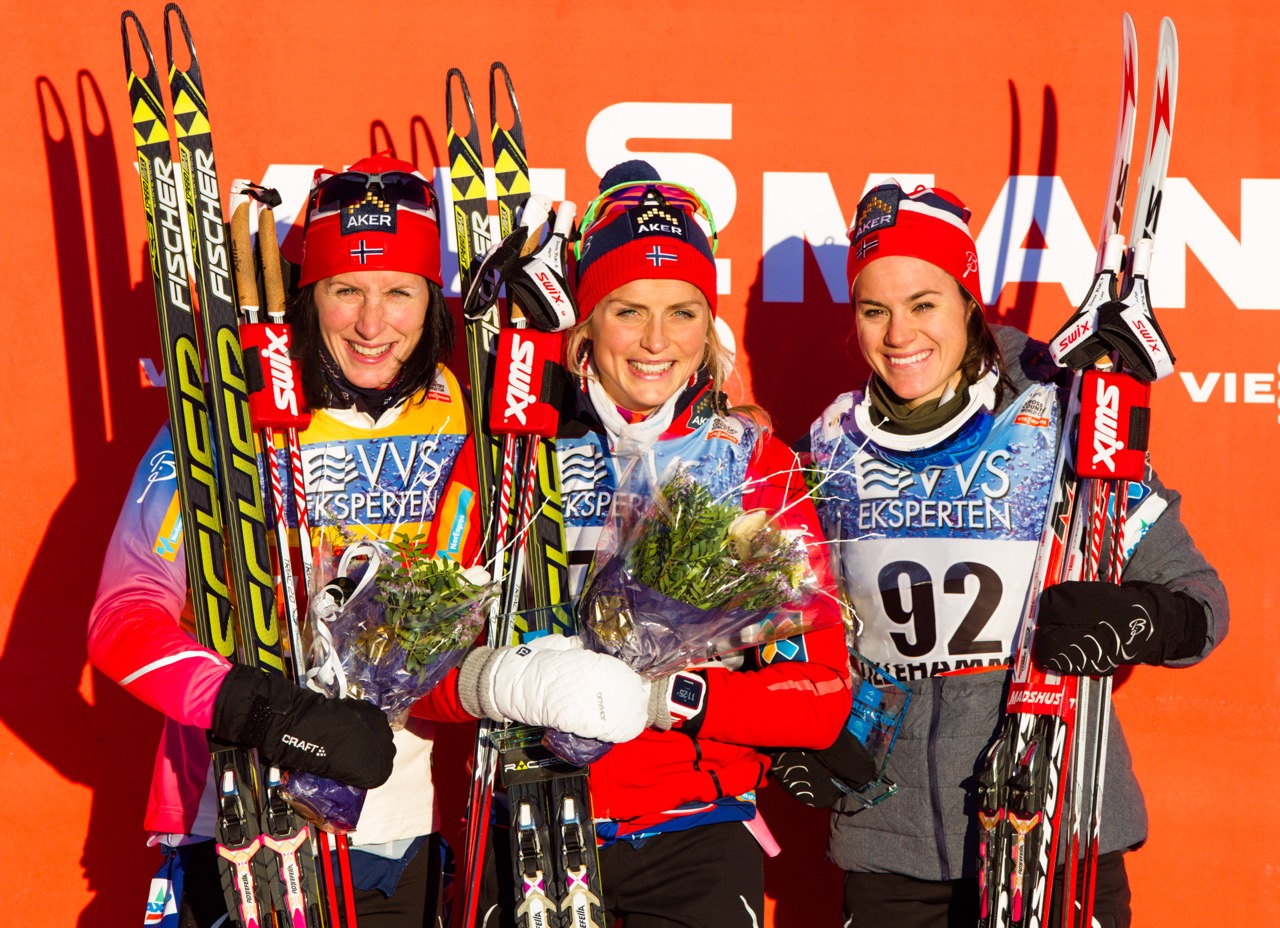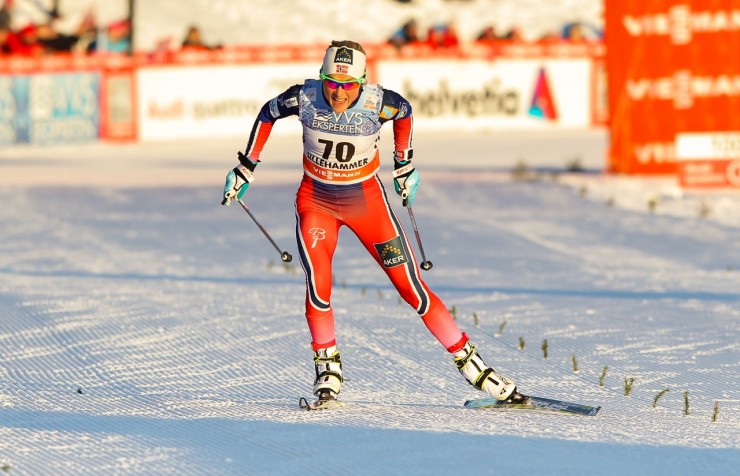
As so often on the World Cup lately, it’s not a question of who will fight for the victory, but how the competition between Marit Bjørgen and Therese Johaug will unfold.
After that, it’s usually interesting to see who will take third behind the two Norwegian powerhouses. In the last two races of the Lillehammer World Cup mini tour in Norway, it’s been their teammate: Heidi Weng.

The women’s 10-kilometer classic pursuit on Sunday was no different. Bjørgen as the mini-tour leader through two races, started 20 seconds ahead of Weng in second and 32 seconds ahead of Johaug in third. For Bjørgen, the classic pursuit — with implications for the Lillehammer triple victory — was all about keeping Johaug behind her.
Not only is the 10 k classic a Johaug speciality so far this season (after she beat Bjørgen handily by 42 seconds in the event last weekend in Kuusamo, Finland), and on a comparably hilly course in Lillehammer, but Johaug also had the advantage of chasing.
The women skied two laps on the same 5-k course they grew familiar with in Saturday’s 5 k freestyle (which Johaug won by 0.3 seconds over Bjørgen). On the first lap of Sunday’s pursuit, Bjørgen lost only about 10 seconds to Johaug. But on the second lap, Bjørgen hit the wall, and she hit it hard.
“I was given splits along the way. It was 29 seconds ahead, 25 seconds, then 13 seconds,” Bjørgen said to reporters after the race. “When I heard 13 seconds, I was thinking, ‘Crap.’ ”
With 1.8 k remaining, she was 12.1 seconds ahead of Johaug, who rocketed to second, half a second ahead of Weng by the 2.2 k mark. At the halfway point, Johaug was 19 seconds behind Bjørgen with Weng still hanging on 0.3 seconds behind her. Weng would stick with the eventual-runner up through the 7.2 k checkpoint and up until the final climb.
With about 1 k to go, Johaug passed Bjørgen before the final climb back to the stadium. Bjørgen appeared to struggle to stay with her, but knew that if she did, she’d have an advantage on the downhill into the stadium.
Coming into the stadium, Johaug remained in the lead until the final turn, where Bjørgen took the inside track to ride up alongside her about 100 meters from the finish.
“When we were even, I was thinking, ‘No way I’m going to let her beat me. I should beat her in a sprint,’ ” Bjørgen said.
But considering the way she looking less than a kilometer earlier when Johaug caught her, it was anyone’s guess how much Bjørgen had left for the finish. She wasn’t sure, either.

“My body was not on my side today. I felt heavy and syrupy, and when you feel like that, the seconds are running away from you really fast,” Bjørgen explained.
She conserved while tucking behind Johaug on the last descent into the stadium, then prepared for her final attack — which left Johaug 0.6 seconds behind at the finish line.
“And with the effort Therese pulled off today, I felt bad beating her in the sprint,” Bjørgen said after winning the pursuit in 28:19.7, just ahead of Johaug and 12.3 seconds ahead of Weng in third. “But a race is a race.”
Despite losing, Johaug was impressed with Bjørgen and pleased with her effort.
“I lost the sprint finish, but I made up 30 seconds on Marit and I had the fastest time for the stage, so that’s my takeaway from the day,” Johaug said. “I did a solid classic race.”
Johaug completed the course in 27:48.2, nearly 24 seconds faster than Weng as the second-fastest woman of the day. Bjørgen’s time ranked third.
“My sprint finish was a lot better than it used to be, and [Marit] definitely didn’t park me today,” Johaug said.
While she didn’t expect to beat Bjørgen in a sprint anytime soon, she explained that Bjørgen’s not unbeatable at that distance, either.
“She’s a tough cookie and almost nobody in the whole world can beat her in a sprint. But I’m not giving up,” Johaug said.
Weng secured third after skiing alone in no-man’s-land for the last kilometer or so.
“Therese came very fast and caught me on the first hill,” she told FIS. “I tried to ski as fast as I could but I could not follow her on the last climb. I am happy about the third podium this season.”
The fourth-place finisher, another Norwegian — Ingvild Flugstad Østberg — crossed the line 1 minute, 26 seconds after Weng. Østberg improved from fifth to fourth by overtaking teammate Ragnhild Haga early on (after starting with her, 14 seconds behind Johaug and 26 seconds behind Weng).
Sweden’s Charlotte Kalla started 1 second behind them in sixth, and by the 2.2 k mark, was up to fifth 0.4 seconds behind Østberg. Haga trailed by another 1.3 seconds in sixth.
At the halfway point, Kalla was up to fourth by 0.4 seconds over Østberg. She continued to lead the Norwegian by the same margin up until the last few hundred meters of the race. In the final stretch toward the finish, Østberg surged hard to drop Kalla, immediately putting at least 10 seconds between them. Østberg secured fourth, 12.6 seconds ahead of Kalla in fifth, and Haga was another 4.4 seconds back in sixth (+1:55.3).
Norway not only swept the top four, but put six in the top seven in the women’s pursuit. Maiken Caspersen Falla, who started eighth, improved to seventh (+2:00.8). About 12 seconds behind her, Finland’s Krista Parmakoski placed eighth (up from 12th). Also for Finland, Kerttu Niskanen followed just 0.2 seconds back in ninth (up from 16th), and Poland’s Justyna Kowalczyk made it into the top 10 in 10th (up from 30th). Kowalczyk started 1:32 behind Bjørgen and finished 2:15.6 after her.
Bjørgen’s second win out of three races in Lillehammer lifted her to her fifth-consecutive mini-tour win and gave her a hefty load of World Cup points with it. She is currently 131 points ahead of Johaug in the overall World Cup standings, and Weng overtook Østberg to put herself third, 84 points behind Johaug.
Inge Scheve
Inge is FasterSkier's international reporter, born and bred in Norway. A cross-country ski racer and mountain runner, she also dabbles on two wheels in the offseason. If it's steep and long, she loves it. Follow her on Twitter: @IngeScheve.



